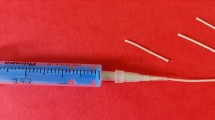Abstract
Experiments were performed to test the null hypothesis that the addition of a natural occurring antibiotic would not alter mechanical properties of polymethylmethacrylate (PMMA). Compression and four-point bending tests were used to assess mechanical properties of zirconium dioxide bearing bone cement (Type Zr) and barium sulfate bearing bone cement (Type Ba), mixed with the antibiotic usnic acid (“usnic”), used to create a surface resistant to biofilm formation. Addition of usnic had a statistically significant effect on the material properties. Compressive and bending strengths decreased as usnic was added and Type Zr was stronger than Type Ba although material properties remained above recommended minima. With implications of liver toxicity with large doses of usnic taken as a dietary supplement, cytotoxicity tests using bone cement coupons were performed and showed very little or no toxicity in primary cultures of rabbit skin derived fibroblasts. A simple test of usnic’s efficacy as a biofilm prophylaxis in PMMA was also conducted. Bone cement coupons with usnic were tested for their effectiveness against methicillin resistant Staphylococcus aureus. Diminished biofilm formation on usnic-containing coupons indicated that usnic can be an effective anti-microbial agent.




Similar content being viewed by others
References
Smeds S, Goertzen D, Ivarsson I. Influence of temperature and vacuum mixing on bone cement properties. Clin Orthop Relat Res. 1997;334:326–34.
Tunney MM, et al. Improved detection of infection in hip replacements. A currently underestimated problem. J Bone Joint Surg Br. 1998;80(4):568–72.
Trampuz A, et al. Sonication of removed hip and knee prostheses for diagnosis of infection. N Engl J Med. 2007;357(7):654–63.
Villa T, Carnelli D. Experimental evaluation of the biomechanical performances of a PMMA-based knee spacer. Knee. 2007;14(2):145–53.
Askew MJ, et al. Effect of vacuum mixing on the mechanical properties of antibiotic-impregnated polymethylmethacrylate bone cement. J Biomed Mater Res. 1990;24(5):573–80.
Buchholz HW, Elson RA, Heinert K. Antibiotic-loaded acrylic cement: current concepts. Clin Orthop Relat Res. 1984;190:96–108.
Cui Q, et al. Antibiotic-impregnated cement spacers for the treatment of infection associated with total hip or knee arthroplasty. J Bone Joint Surg Am. 2007;89(4):871–82.
He Y, et al. Effect of antibiotics on the properties of poly(methylmethacrylate)-based bone cement. J Biomed Mater Res. 2002;63(6):800–6.
Lautenschlager EP, et al. Mechanical properties of bone cements containing large doses of antibiotic powders. J Biomed Mater Res. 1976;10(6):929–38.
Levin PD. The effectiveness of various antibiotics in methyl methacrylate. J Bone Joint Surg Br. 1975;57(2):234–7.
Marks KE, Nelson CL, Lautenschlager EP. Antibiotic-impregnated acrylic bone cement. J Bone Joint Surg Am. 1976;58(3):358–64.
Durbhakula SM, et al. Spacer endoprosthesis for the treatment of infected total hip arthroplasty. J Arthroplast. 2004;19(6):760–7.
Pitto RP, Spika IA. Antibiotic-loaded bone cement spacers in two-stage management of infected total knee arthroplasty. Int Orthop. 2004;28(3):129–33.
Armstrong MS, et al. Mechanical characteristics of antibiotic-laden bone cement. Acta Orthop Scand. 2002;73(6):688–90.
Klekamp J, et al. The use of vancomycin and tobramycin in acrylic bone cement: biomechanical effects and elution kinetics for use in joint arthroplasty. J Arthroplast. 1999;14(3):339–46.
Leone J, et al. Biaxial flexural modulus of antibiotic-impregnated orthopedic bone cement. J Biomed Mater Res B Appl Biomater. 2007;83(1):97–104.
Mohd Fuad D, et al. Biomechanical properties of bone cement with addition of cefuroxime antibiotic. Med J Malaysia. 2006;61(Suppl A):27–9.
Neu HC. The crisis in antibiotic resistance. Science. 1992;257(5073):1064–73.
Tunney MM, et al. Antimicrobial susceptibility of bacteria isolated from orthopedic implants following revision hip surgery. Antimicrob Agents Chemother. 1998;42(11):3002–5.
Baleani M, et al. Biological and biomechanical effects of vancomycin and meropenem in acrylic bone cement. J Arthroplast. 2008;23:1232–8.
Guo L, et al. Review of usnic acid and Usnea barbata toxicity. J Environ Sci Health C Environ Carcinog Ecotoxicol Rev. 2008;26(4):317–38.
Parsek MR, Singh PK. Bacterial biofilms: an emerging link to disease pathogenesis. Annu Rev Microbiol. 2003;57(2):677–701.
Lewis K. Riddle of biofilm resistance. Antimicrob Agents Chemother. 2001;45(4):999–1007.
Stoodley P, et al. Direct demonstration of viable Staphylococcus aureus biofilms in an infected total joint arthroplasty. A case report. J Bone Joint Surg Am. 2008;90(8):1751–8.
Francolini I, et al. Usnic acid, a natural antimicrobial agent able to inhibit bacterial biofilm formation on polymer surfaces. Antimicrob Agents Chemother. 2004;48(11):4360–5.
Dunne NJ, Orr JF. Influence of mixing techniques on the physical properties of acrylic bone cement. Biomaterials. 2001;22(13):1819–26.
Pieters R, et al. Adaptation of the rapid automated tetrazolium dye based (MTT) assay for chemosensitivity testing in childhood leukemia. Cancer Lett. 1988;41(3):323–32.
Linden U. Mechanical properties of bone cement. Importance of the mixing technique. Clin Orthop Relat Res. 1991;272:274–8.
Persson C, et al. Mechanical effects of the use of vancomycin and meropenem in acrylic bone cement. Acta Orthop. 2006;77(4):617–21.
Dunne N, et al. In vitro study of the efficacy of acrylic bone cement loaded with supplementary amounts of gentamicin: effect on mechanical properties, antibiotic release, and biofilm formation. Acta Orthop. 2007;78(6):774–85.
Holm NJ. The modulus of elasticity and flexural strength of some acrylic bone cements. Acta Orthop Scand. 1977;48(5):436–42.
Nelson RC, Hoffman RO, Burton TA. The effect of antibiotic additions on the mechanical properties of acrylic cement. J Biomed Mater Res. 1978;12(4):473–90.
Ginebra MP, et al. Mechanical performance of acrylic bone cements containing different radiopacifying agents. Biomaterials. 2002;23(8):1873–82.
Kjellson F, et al. Effect of iodixanol particle size on the mechanical properties of a PMMA based bone cement. J Mater Sci Mater Med. 2007;18(6):1043–51.
Liu C, et al. Some failure modes of four clinical bone cements. Proc Inst Mech Eng [H]. 2001;215(4):359–66.
Chitturi S, Farrell GC. Hepatotoxic slimming aids and other herbal hepatotoxins. J Gastroenterol Hepatol. 2008;23(3):366–73.
Davies JP, et al. Influence of antibiotic impregnation on the fatigue life of Simplex P and Palacos R acrylic bone cements, with and without centrifugation. J Biomed Mater Res. 1989;23(4):379–97.
Author information
Authors and Affiliations
Corresponding author
Rights and permissions
About this article
Cite this article
Kim, S., Greenleaf, R., Miller, M.C. et al. Mechanical effects, antimicrobial efficacy and cytotoxicity of usnic acid as a biofilm prophylaxis in PMMA. J Mater Sci: Mater Med 22, 2773–2780 (2011). https://doi.org/10.1007/s10856-011-4445-x
Received:
Accepted:
Published:
Issue Date:
DOI: https://doi.org/10.1007/s10856-011-4445-x




